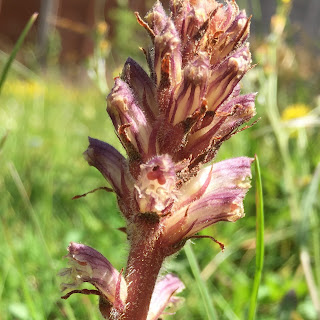I was nearly going to call this The Orchid Round-Up and then realised I might be mistaken for advertising a proprietary brand of herbicide, which just wouldn't be in keeping with the tone of this piece by a long chalk.
Of chalk .. as the summer progressed I was hoping to encounter and enjoy new orchid species, but without the will to "twitch" much further than my usual haunts and petrol allowance, this was always going to be difficult to achieve.
So consider this lazy botanising, taking advantage of a little bit of local knowledge and in some cases getting the timing so wrong that the plant itself was way past best. A couple of interesting orchid variations appeared along the way, and I also met with two new (to me) species of parasitic plants. One of which I was to find in the back garden.
 |
| Dactylorhiza fuchsii |
This variation of common-spotted orchid caused much interest at Fairmile Bottom in June. Despite asking twice about the name of the variation, I didn't manage to hear the answer / retain the answer properly and so think it may be Rosa?? something or other. I thought it rude to ask a third time?
 |
| Dactylorhiza viridis X Dactylorhiza fuchsii |
The hybrid frog orchid x common spotted orchid also known as
X Dactyloglossum mixtum was at a site I have been asked not to disclose. When I saw it the flowers were just starting to go over. Despite this it was still a stunning plant to encounter.
For more
Dactylorhiza hybrid names and details it's worth checking out:
wildflowerfinder.org.uk
 |
| Epipactis helleborine |
Another species lacking in its former glory was the broad-leaved helleborine. One of two plants which were growing on a West Sussex, Notable Road Verge [NRV]. However, both were obviously deer browsed. No doubt by the locally abundant fallow (
Dama dama). I've been told that previous counts of this helleborine, in this location, have been as high as eight individuals. The NRV also has a historical record for fly honeysuckle (
Lonicera xylosteum) which we may or may not have identified correctly on the day depending on who you show the photographs too. So the jury's out on that one until next year when I shall look earlier in the flowering period, and hopefully get to see the helleborines in better condition as well?
The start of July saw us in Somerset chasing butterflies (see the July 2nd Blog entry). I had also hoped to catch up with greater butterfly orchid (
Platanthera chlorantha), and a search of the tall grassland on the walk back from Collard Hill to the Car Park produced one specimen flower over / gone to seed.
 |
| Platanthera chlorantha |
Of parasitic plants .. in end May / early June I encountered a broomrape sp. growing out of the garden lawn - just a foot away from the base of the washing line. I watched it grow and begin to flower and had narrowed it down to either ivy broomrape (
Orobanche hederae) or common broomrape (
Orobanche minor) by June 9th - consulting a friend and botanist via WhatsApp I was advised to wait until the flowers fully opened and then check the colour of the stigma - yellow for ivy, purple for common.
By June 11th the flowers had started to open and I managed both a close up look and a photograph which confirmed the plant as
O. minor. At time of writing I am still watching it in slow decay withering to a tufted stick. If we put the pond in as planned I will have to translocate that section of turf to elsewhere in the garden.
 |
| O. minor 9th June 2017 |
 |
O. minor 11th June 2017
with purple stigma confirming ID
|
A quiet working day mid-July, and I received a phone call from a colleague advising me to drop by her site, on my way through to Burton Mill Pond. One of the volunteers who undertakes surveys and monitoring on this site, had recently discovered two flowering spikes of yellow bird's-nest (
Monotropa hypopitys). I had never even heard of this plant and due to it's common name initially reached for the orchid guide to get my eye in before the site visit. Not finding it there I reached for Collins, and there it was - the only UK plant in the family MONOTROPACEAE. So I had to take a look.
 |
| Monotropa hypopitys |
In the process of writing this blog entry my research has discovered that yellow bird's-nest obtains it's nutrients from a parasitic relationship with mycorrhizal fungi. Which begs the question: Just how baffling and complex is the evolutionary process to produce such a unique plant?
 |
| Spiranthes spiralis |
My last two photographs do little justice to the beauty and delicacy of the orchid that is Autumns Lady's-tresses. But I am unashamed - being content to have finally met with this little gem.
I started actively looking for this plant last year, on a local site, whose interpretation boasts of its presence along with up to seven other orchid species. I worried that I didn't "have my eye in" and wandered around on several evenings trying to find it - to no avail. On Sunday we went to Noar Hill because I had seen photos posted on FB that they were in flower there. I worried that I might miss them - but they jumped out of the short turf - and once I saw one - we saw loads, loads (I didn't count how many).
Having enjoyed the spectacle at Noar Hill - which also included a sighting of brown hairstreak (
Thecla betulae) - we dropped back into Catherington Down on the way home and searched again for the lady's-tresses, as I had done last year. We still couldn't find any.